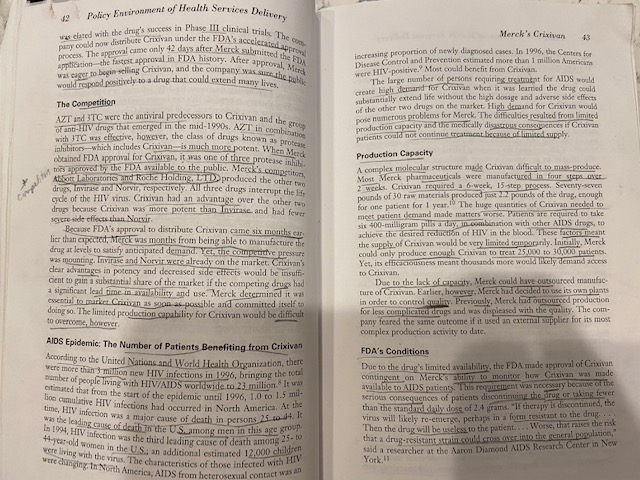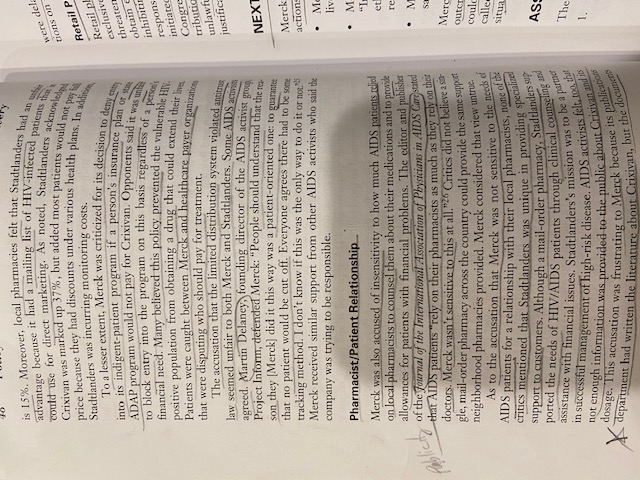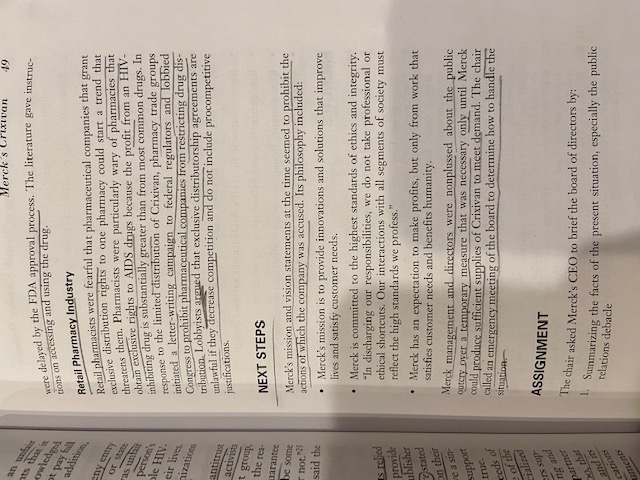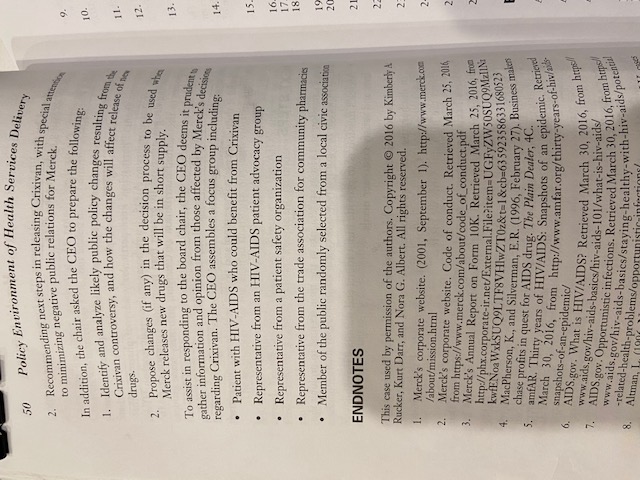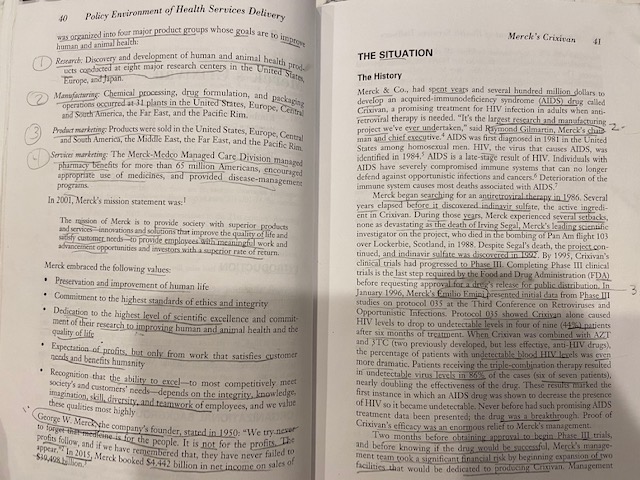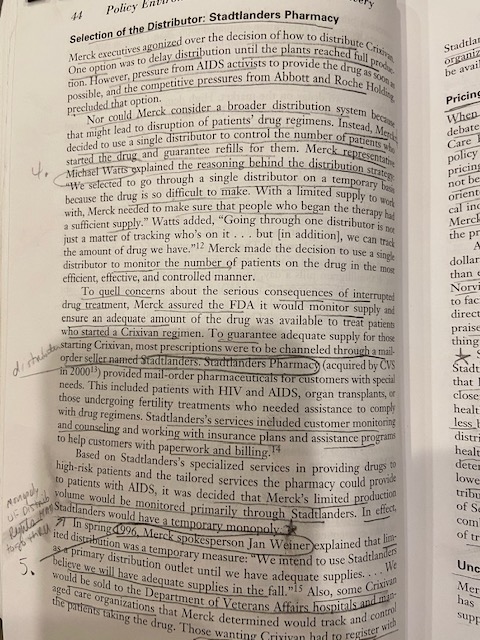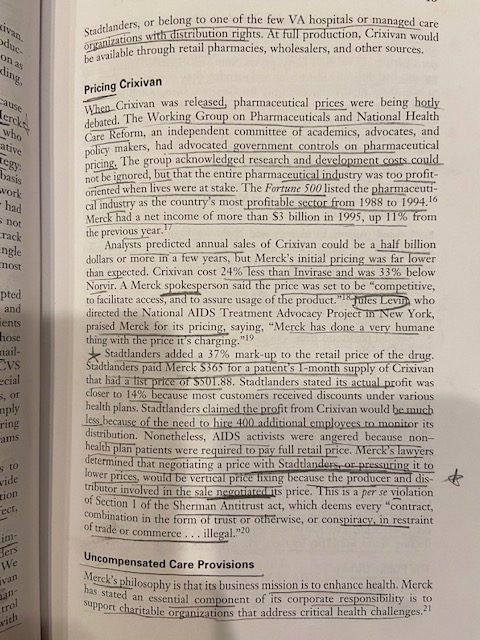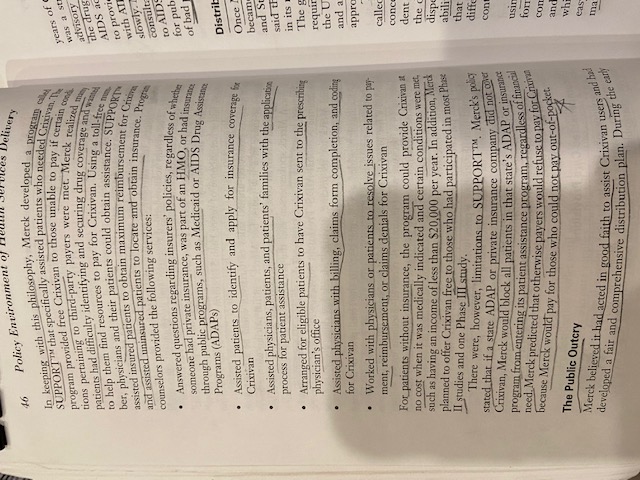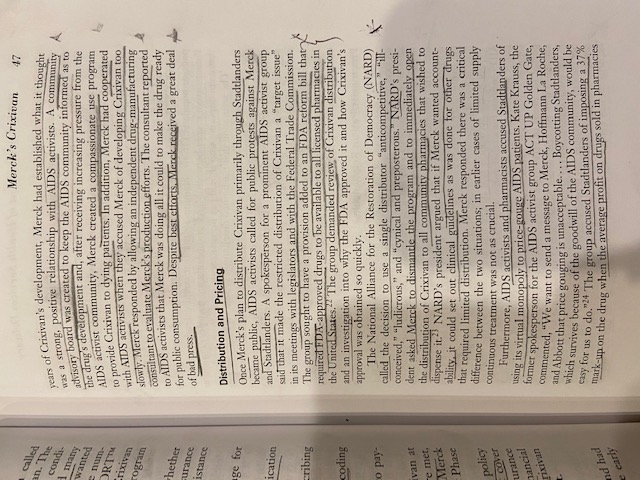Policy Environment of Health Services Delivery " cited with the drug's success in Phase III clinical trials. The con PLOT could now distribute Crixivan under the FDA's accelemicu appro Merck's Crixivan Pieces, The approval came only 47 days after Merck submitted the FDA Application-the fairest approval in FDA history. After approval, Merck increasing proportion of newly diagnosed cases. In 1906, the Centers for Wil eager to begin selling Crixian, and the company was sure the public Disease Control and Prevention estimated more than 1 million American would respond positively to a drug that could extend many lives. were HIV positive." Most could benefit from Crisivin. The large number of persons requiring treatment for AIDS would The Competition create high demand for Cravin when it was learned the drug could substantially extend life without the high dosage and adverse side effects AZT and 3TC were the antiviral predecessors to Crixivan and the group of the other two drugs on the market. High demand for Crisivan would of anti-HIV drugs that emerged in the mid-1990s. AXT in combination poke numerous problems for Merck, The difficulties resulted from limited with ITC was effective, however, the class of drugs known as protest production capacity and the medically disisargus consequences if Crisivan inlubitors-which includes Crixivan is much more potent. When Merck patients could not continue treatment because of limited supply. obtained FDA approval for Crixivan, it was one of three protease inhibit Production Capacity h toes thanwed by the FDA available to the public. Merck's competitors, Itfor Laboratories and Roche Holding. LTD. produced the other two A complex malecalar structure made Cristran difficult to may-produce. drugs, Invirase and Norer, respectively. All three drugs interrupt the lift Most Merck pharmaceuticals were manufactured in four steps over cycle of the HIV virus. Crixivan had an advantage over the other top 2 weeks. Crinivan required a 6 week, 15 step process. Seventy-seven pounds of 30 raw materials produced jose 2.2 pounds of the drag, enough drugs because Crisman was more potent than Inxicase and had fewer for one patient for 1 year." The huge quantities of Crisivan needed to Sacre side effect than Monar. meet patient demand made matters were. Parents are required to take Becine FDA's approval to distribute Crixivan came six months car. six 400-milligram pills a day, in combination with other AIDS drugs, In lier than expected, Merck was months from being able to manufacture the achieve the desired reduction of HIV in the blood. These factor meant drug at levels to satisfy anticipated demand. Yet, The competitive pressure the supply of Crixivan would be very limited temporinly. Initially, Merck was mounting. Inarase and Nonear were already on the market, Crixivan's could only produce enough Crinivan to treat 25 000 to 10,000 patients. dear advantages in potency and decreased side effects would be insuffer Yet, its efficaciousmess meant thousands more would likely demand access cient to gain a substantial share of the market if the competing drugs had to Crianan. a significant lead time in mailability and use. Merck determined it was Dee to the lack of capacity, Merck could have outsourced manufac essential to market Craivan as soon as possible and committed itself to cure of Crivivan. Earlier, however, Merck had decided to use its own plants doing so. The limited production capability for Crixivan would be difficult in order to control quality. Previously, Merck had outsourced production to overcome, however. for less complicated drugs and was displeased with the quality. The com- pany feared the same outcome if it used an external supplier for its most AIDS Epidemic: The Number of Patients Benefiting from Crixivan complex production activity to date. According to the United Nations and World Health Organization, there FDA's Conditions were more than 3 million new HIV infections in 1996, bringing the total Due to the drag's limited availability, the FDA made approval of Crixivan Bamber of people living with HIVAIDS worldwide to 23 million. It was contingent on Merck's ability to monitor how Crisivan was made estimated that from the start of the epidemic until 1996, 1.0 to 1.5 mil- available to AIDS patients. This requirement was necesary because of the lion cumulative HIV infections had occurred in North America. At the serious consequences of patients discontinuing the drug or taking fewer time, HIV infection was a major cause of death in persons 25 so-44. It than the standard daily dose of 2.4 grants. "If therapy is discontinued, the was the leading cause of death in the U.S. among men in this age group. virus will likely re-emerge, perhaps in a form resistant to the drug. . . . In 1904, HIV infection was the third leading cause of death among 25-to Then the drug will be useless to the patient. .. . Worse, that raises the mick Hi-year-old women in the U.S.; an additional estimated 12,000 children that a drug-resistant strain could cross over into the general population," were living with the virus, The characteristics of those infected with HIV said a researcher at the Aaron Diamond AIDS Research Center in New were chinging. In North America, AIDS from heterosexual contact was an York.!13 Merck's Crixivan Kimberly A. Rucker Healthcare Consultant, Washington, D.C. Kurt Darr The George Washington University, Washington, D.C. Nora G. Albert Children's National Health System, Washington, D.C. 10- ing ers. INTRODUCTION inc. hots. Resource allocation, scarcity, pricing, and stakeholder involvement are recurring issues in healthcare. The treatment for HIV discussed in this mand case is no longer groundbreaking; the lessons remain salient. A current shot- example is Gilead's hepatitis G drug, Sovaldi, that costs $1,000 per pill, of more than $84,000 per patient in a course of treatment. Demand for shots Sovaldi is high, but its cost causes access problems for many patients. How h-risk should a costly, scarce resource be allocated? Does Gilead have a respon sibility to increase access to Sovaldi? Merck's Crixivan offers insight ing such issues. unites rity for S.COM ORGANIZATIONAL BACKGROUND vaccine lu shots Merck & Co., Inc., is a research-driven pharmaceutical products and ser- vices company headquart adquartered In Kenilworth, New Jersey. In 2001, Merck Retrieved syed From 39is 15%. Moreover, local pharmacies felt that Stadtlanders had an ure advantage because it had a mailing list of HIV-infected patients could use for direct marketing. As noted, Stadtlanders acknowledg were del Crixivan was marked up 37%, but added most patients would not pay tions on Price because they had discounts under various health plans. In addition Stadtlanders was incurring monitoring costs. Retail F To a lesser extent, Merck was criticized for its decision to deny ent Retail p into its indigent-patient program if a person's insurance plan or s exclusiv ADAP program would not pay for Crixivan. Opponents said it was un threater to block entry into the program on this basis regardless of a person obtain financial need. Many believed this policy prevented the vulnerable HI inhibiti positive population from obtaining a drug that could extend their live respons Patients were caught between Merck and healthcare payer organization initiate Congre that were disputing who should pay for treatment. tributi The accusation that the limited distribution system violated antics unlawt law seemed unfair to both Merck and Stadtlanders. Some AIDS active justific agreed. Martin Delaney, founding director of the AIDS activist group Project Inform, defended Merck: "People should understand that the re- son they [Merck] did it this way was a patient-oriented one: to guarantee NEX that no patient would be cut off. Everyone agrees there had to be some tracking method. I don't know if this was the only way to do it or not." Merck Merck received similar support from other AIDS activists who said the action company was trying to be responsible. M liv Pharmacist/Patient Relationship_ M Merck was also accused of insensitivity to how much AIDS patients relied on local pharmacists to counsel them about their medications and to provide et allowances for patients with financial problems. The editor and publisher re Publicity of the Journal of the International Association of Physicians in AIDS Care stated M that AIDS patients "rely on their pharmacists as much as they rely on ther 5: doctors. Merck wasn't sensitive to this at all."?Critics did not believe a sin gle, mail-order pharmacy across the country could provide the same support Merc outo neighborhood pharmacies provided. Merck considered that view untrue could As to the accusation that Merck was not sensitive to the needs of calle AIDS patients for a relationship with their local pharmacists, none of the situa critics mentioned that Stadtlanders was unique in providing specialize support to customers. Although a mail-order pharmacy, Stadtlanders sup ported the needs of HIV/AIDS patients through clinical counseling AS! assistance with financial issues. Stadtlanders's mission was to be a parts in successful management of high-risk disease. AIDS activists felt, too. that The 1. X depa not enough information was provided to the public about Crixivan and 16 dosage. This accusation was frustrating to Merck because its publication department had written the literature about Crixivan, but the documentMerck's Crixivan 49 an unbis its that it owledged were delayed by the FDA approval process. The literature gave instruc- t pay fall tions on accessing and using the drug. addition. Retail Pharmacy Industry eny entry Retail pharmacists were fearful that pharmaceutical companies that grant or start exclusive distribution rights to one pharmacy could start a trend that as unbin threatens them. Pharmacists were particularly wary of pharmacies that obtain exclusive rights to AIDS drugs because the profit from an HIV- person's le HIV. inhibiting drug is substantially greater than from most common drugs, In response to the limited distribution of Crixivan, pharmacy trade groups sir lives initiated a letter-writing campaign to federal regulators and lobbied nizations Congress to prohibit pharmaceutical companies from restricting drug dis- tribution. Lobbyists argued that exclusive distributorship agreements are antitrust unlawful if they decrease competition and do not include procompetitive justifications. I TOLD the rea- barantee NEXT STEPS be some not Merck's mission and vision statements at the time seemed to prohibit the said the actions of which the company was accused. Its philosophy included: . Merck's mission is to provide innovations and solutions that improve lives and satisfy customer needs. . Merck is committed to the highest standards of ethics and integrity. is relied "In discharging our responsibilities, we do not take professional or provide ethical shortcuts. Our interactions with all segments of society must ublisher reflect the high standards we profess." Dstated . Merck has an expectation to make profits, but only from work that on their satisfies customer needs and benefits humanity. C a sin Merck management and directors were nonplussed about the public support outery over a temporary measure that was necessary only until Merck could produce sufficient supplies of Crixivan to meet demand. The chair beds of called an emergency meeting of the board to determine how to handle the of the situation. Cialized ASSIGNMENT ng and partner why that The chair asked Merck's CEO to brief the board of directors by: and its 1. Summarizing the facts of the present situation, especially the public relations debacle Ument50 Policy Environment of Health Services Delivery " Recommending next steps in releasing Crixivan, with special attent to minimizing negative public relations for Merck. In addition, the chair asked the CEO to prepare the following: 1. Identify and analyze likely public policy changes resulting from 10 11. drugs. Crixivan controversy, and how the changes will affect release of ney 2. Propose changes (if any) in the decision process to be used why 12. Merck releases new drugs that will be in short supply. 13. To assist in responding to the board chair, the CEO deems it prudent gather information and opinion from those affected by Merck's decision regarding Crixivan. The CEO assembles a focus group including: 14. . Patient with HIV-AIDS who could benefit from Crixivan . Representative from an HIV-AIDS patient advocacy group 15 . Representative from a patient safety organization 16 17 . Representative from the trade association for community pharmacies 18 . Member of the public randomly selected from a local civic association 19 20 ENDNOTES 21 This case used by permission of the authors. Copyright @ 2016 by Kimberly A Rucker, Kurt Darr, and Nora G. Albert. All rights reserved. 1. Merck's corporate website. (2001, September 1). http://www.merck.com 2. /about/mission.html Merck's corporate website. Code of conduct. Retrieved March 25, 2016 3. from https://www.merck.com/about/code_of_conduct.pdf Merck's Annual Report on Form 10K. Retrieved March 25, 2016, from http://phx.corporate-ir.net/External.File?item=UGFyZW50SUQ9MalIN 4. kwfENoa WxkSUQ9LTF8VHIwZTOz&t=1 &ch=635923586331680523 MacPherson, K., and Silverman, E.R. (1996, February 27). Business maker 5. chase profits in quest for AIDS drug. The Plain Dealer, 4C. amfAR. Thirty years of HIV/AIDS: Snapshots of an epidemic. Retrieved 6. March 30, 2016, from http://www.amfar.org/thirty-years-of-hivfails snapshots-of-an-epidemic/ 7. AIDS.gov. What is HIVAIDS? Retrieved March 30, 2016, from hupeh www.aids.gowhiv-aids-basics/hiv-aids-101/what-is-hiv-aids/ . AIDS.gov. Opportunistic infections. Retrieved March 30, 2016, from hupeh 3. www.aids.gov/hiv-aids-basics/staying-healthy-with-hiv-aids/potential -related-health-problems/opportun Altman, L. (10Policy Environment of Health Services Delivery "organized into four major product groups whose goals are to incar Merck's Crixivan 41 human and animal health: | ) Research, Discovery and development of human and animal health prod. THE SITUATION Wits conducted at eight major research centers in the United States, Europe, and Japan. The History Manufacturing Chemical processing, drug formulation, and packaging Merck & Co., had spent years and several hundred million dollars to operations occurred at il plants in the United States, Europe, Comtry develop an acquired immunodeficiency syndrome (AIDS) drug called and South America, the Far East, and the Pacific Rim. Crisivan, a promising treatment for HIV infection in adults when anti- retroviral therapy is needed. "It's the largest research and maniafacturing -, Prader marketing Products were sold in the United States, Europe, Central project we've ever undertaken," said Raymond Gilmartin, Merck's chip- and South America, the Middle East, the Far East, and the Pacific Rim man and chief executive." AIDS was first diagnosed in 1981 in the United States among homosexual men. HIV, the virus that class AIDS, was Some marketing The Merck-Medco Managed Care Division managed identified in 1984.' AIDS is a late-stage result of HIV. Individuals with pharmacy benefits for more than 65 million Americans, encouraged AIDS have severely compromised immune systems that can no longer appropriate use of medicines, and provided disease-management defend against opportunistic infections and cancers Deterioration of the programs Immune system causes most deaths associated with AIDS.? In 2001, Merck's mission statement was.! Merck began searching for an antiretroviral therapy in 1985. Several years elapsed before it discovered isdimavir sulfate, the active ingredi ent in Crixivan. During those years, Merck experienced several setbacks, The manion of Merck is to provide society with superior products none as devastating as the death of Irving Segal, Merck's leading scientific and services innovations and solutions that improve the quality of life and wify customer needs to provide employees with meaningh I work and investigator on the project, who died in the bombing of Pan Am flight 103 achancetrent opportunities and locators with a superior rite of return. over Lockerbie, Scotland, in 1988. Despite Segal's death, the project con- tinued, and indiavir sulfite was dixoncred in VON. By 1995, Crixivan's Merck embraced the following values: Motrougoats clinical trials had progressed to Phase III. Completing Phase III clinical trial is the last step required by the Food and Drug Administration (FDA) Preservation and improvement of human life before requesting approval for a dreg's release for public distribuation. In . Commitment to the highest standards of ethics and integrity January 1996. Merck's Emilio Emini presented Initial data from Phase III studies on protocol 035 at the Third Conference on Retroviruses and . Dedication to the highest level of scientific excellence and commit- Opportunistic Infections, Protocol 235 showed Grixivan alone caused ment of their research to improving human and animal health and the HIV levels to drop to undetectable levels in four of nine (4124) putjents quality of life after six months of treatment. When Crisivan was combined with AZT Expectation of profits, but only from work that satisfies customer and 3TC (two previously developed, but less effective, and-HIV drugs) the percentage of patients with undetectable blood HIV levels was even needs and benefits humanity more dramatic. Patients receiving the triple-combination therapy resulted Recognition that the ability to excel-to most competitively meet in undetectable virus levels in 8045 of the cases (six of seven patients), society's and cactomers' needs-depends on the integrity, knowledge. nearly doubling the effectiveness of the drug. These results marked the imagination, skill, diversity. and teamwork of employees, and we value first instance in which an AIDS drug was shown to decrease the presence these qualities most highly of HIV so it became undetectable. Never before had such promising AIDS George W. Merely che company's founder, stated in 1950. "We try never treatment data been presented; the drag ans a breakthrough. Proof of to forget fill medicine is for the people. It is Crixivan's efficacy was an enormous relief to Merck's management. ple. It is not for the pro profits follow, and if we have remembered that, they have never f he profits The s before ohraining approval to begin Phase III trials, never failed to appear. " In 2015, Merck booked $4.442 billion in net income on sales of and before knowing if the drug would be sureesful, Merck's manage- ment team took a significant financial risk by beginning expansion of two facilities that would be dedicated to producing Grovan, Management44 Policy Entre Selection of the Distributor: Stadtlanders Pharmacy Merck executives agonized over the decision of how to distribute Cri One option was to delay distribution until the plants reached full prod Stadtla don. However, pressure from AIDS activists to provide the drug as sort Possible, and the competitive pressures from Abbott and Roche Holding be avai precluded that option. Nor could Merck consider a broader distribution system bec Pricing that might lead to disruption of patients' drug regimens. Instead, Me When decided to use a single distributor to control the number of patients y debate started the drug and guarantee refills for them. Merck representat Care Michael Watts explained the reasoning behind the distribution strife policy "We selected to go through a single distributor on a temporary be pricing because the drug is so difficult to make. With a limited supply to work not be with, Merck needed to make sure that people who began the therapy had orien cal in a sufficient supply." Watts added, "Going through one distributor is no Mere just a matter of tracking who's on it . . . but [in addition], we can track the pr the amount of drug we have."12 Merck made the decision to use a singh distributor to monitor the number of patients on the drug in the most dollar efficient, effective, and controlled manner. than To quell concerns about the serious consequences of interrupted Nor drug treatment, Merck assured the FDA it would monitor supply and to fac ensure an adequate amount of the drug was available to treat patient direct who started a Crixivan regimen. To guarantee adequate supply for those praise hendrixIvan, most prescriptions were to be channeled through a mal- thing order seller named Stadtlanders. Sendlanders Pharmacy (acquired by CVS in 2000#3) provided mail-order pharmaceuticals for customers with special Stadt needs. This included patients with HIV and AIDS, organ transplants, or that those undergoing fertility treatments who needed assistance to comply close with drug regimens. Stadtlanders's services included customer monitoring healt and counseling and working with insurance plans and assistance program less to help customers with paperwork and billing.# dist Based on Stadtlanders's specialized services in providing drugs to heal high-risk patients and the tailored services the pharmacy could provide dete to patients with AIDS, it was decided that Merck's limited production lowe volume would be monitored primarily through Stadtlanders. In effect tribu Stadtlanders would have a temporary monopoly:32 of S In spring (996. Merck spokesperson Jan Weiner explained that lim com of tr 5. ited distribution was a temporary measure: "We intend to use Stadtlanders as a primary distribution outlet until we have adequate supplies. . . ." believe we will have adequate supplies in the fall. "15 Also, some Crixivan Unc would be sold to the Department of Veterans Affairs hospitals and my aged care organizations that Merck determined would track and control Mer has the patients taking the drug. Those wanting supp to register withIvan Stadtlanders, or belong to one of the few VA hospitals or managed care organizations with distribution rights. At full production, Crixivan would on as be available through retail pharmacies, wholesalers, and other sources. ding Pricing Crixivan Cause When Crixivan was released, pharmaceutical prices were being hotly ercks debated. The Working Group on Pharmaceuticals and National Health who Care Reform, an independent committee of academics, advocates, and ative policy makers, had advocated government controls on pharmaceutical regy: pricing. The group acknowledged research and development costs could basis not be ignored, but that the entire pharmaceutical industry was too profit- work oriented when lives were at stake. The Fortune 500 listed the pharmaceuti had al industry as the country's most profitable sector from 1988 to 1994.16 not Merck had a net income of more than $3 billion in 1995, up 11% from rack the previous year. 17 Ingle Analysts predicted annual sales of Crixivan could be a half billion most dollars or more in a few years, but Merck's initial pricing was far lower than expected. Crixivan cost 24% less than Invirase and was 33% below pted Norvir. A Merck spokesperson said the price was set to be "competitive, and to facilitate access, and to assure usage of the product."Jules Levin who tents directed the National AIDS Treatment Advocacy Project in New York, hose praised Merck for its pricing, saying, "Merck has done a very humane thing with the price it's charging."19 nail- CVS Stadtlanders added a 37% mark-up to the retail price of the drug. Stadtlanders paid Merck $365 for a patient's 1-month supply of Crixivan ecial that had a list price of $501.88. Stadtlanders stated its actual profit was 5, OF closer to 14% because most customers received discounts under various aply health plans. Stadtlanders claimed the profit from Crixivan would be much ring less because of the need to hire 400 additional employees to monitor its distribution. Nonetheless, AIDS activists were angered because non- health plan patients were required to pay full retail price. Merck's lawyers determined that negotiating a price with Stadtlanders, or pressuring it to ride lower prices, would be vertical price fixing because the producer and dis- tributor involved in the sale negotiated its price. This is a per se violation of Section 1 of the Sherman Antitrust act, which deems every "contract, combination in the form of trust or otherwise, or conspiracy, in restraint of trade or commerce . . . illegal."20 ers We Uncompensated Care Provisions Merck's philosophy is that its business mission is to enhance health. Merck trol has stated an essential component of its corporate responsibility is to with support charitable organizations that address critical health challenges,2116 Policy Environment of s Delivery In keeping with this philosophy, Merck developed a program SUPPORTTM that specifically assisted patients who needed Crixivan, The Program provided free Crixivan to those unable to pay if certain el tons pertaining to third-party payers were met. Merck realized mas years of Patients had difficulty identifying and securing drug coverage and way was a st to help them find resources to pay for Crixivan. Using a toll-free med advisory the drug ber, physicians and their patients could obtain assistance. SUPPORT AIDS a assisted insured patients to obtain maximum reimbursement for Crisis to provi and assisted uninsured patients to locate and obtain insurance. Progs with AT counselors provided the following services: slowly. consult Answered questions regarding insurers' policies, regardless of whet to AID someone had private insurance, was part of an HMO. or had insurance for pub through public programs, such as Medicaid or AIDS Drug Assistance of bad Programs (ADAPs) . Assisted patients to identify and apply for insurance coverage for Distrib Crixivan Once . Assisted physicians, patients, and patients' families with the application becam and St process for patient assistance said th . Arranged for eligible patients to have Crixivan sent to the prescribing in its physician's office Theg requit . Assisted physicians with billing, claims form completion, and coding the U for Crixivan and a . Worked with physicians or patients to resolve issues related to pay- appro ment, reimbursement, or claims denials for Crixivan caller For patients without insurance, the program could provide Crixivan at cone no cost when it was medically indicated and certain conditions were met dent such as having an income of less than $20,000 per year. In addition, Menk the planned to offer Crixivan free to those who had participated in most Phase disp II studies and one Phase III study. abili There were, however, limitations to SUPPORTTM. Merck's policy that stated that if a state ADAP or private insurance company did not over diff Crixivan, Merck would block all patients in that state's ADAP or insurance con program from entering its patient assistance program, regardless of financial need. Merck predicted that otherwise payers would refuse to pay for Crixivin USi because Merck would pay for those who could not pay out-of-pocket for con The Public Outcry and wh Merck believed it had acted in good faith to assist Crixivan users and had developed a fair and comprehensive distribution plan. During the ear maMerck's Crixivan called 47 an. The condi years of Crixivan's development, Merck had established what it thought 1 many aas a strong, positive relationship with AIDS activists. A community A wanted advisory board was created to keep the AIDS community informed as to enum- the drug's development and, after receiving increasing pressure from the RTTM AIDS activist community, Merck created a compassionate use program rixivan m provide Crixivan to dying patients. In addition, Merck had cooperated with AIDS activists when they accused Merck of developing Crixivan too togram slowly. Merck responded by allowing an independent drug-manufacturing consultant to evaluate Merck's production efforts. The consultant reported hether to AIDS activists that Merck was doing all it could to make the drug ready urance for public consumption. Despite best efforts. Merck received a great deal A istance of bad press. Distribution and Pricing ge for Once Merck's plan to distribute Crixivan primarily through Stadtlanders became public, AIDS activists called for public protests against Merck ication and Stadtlanders. A spokesperson for a prominent AIDS activist group said that it made the restricted distribution of Crixivan a "target issue" cribing in its meetings with legislators and with the Federal Trade Commission. The group sought to have a provision added to an FDA reform bill that required FDA approved drugs to be available to all licensed pharmacies in coding the United States." The group demanded review of Crixivan distribution and an investigation into why the FDA approved it and how Crixivan's approval was obtained so quickly. o pay- The National Alliance for the Restoration of Democracy (NARD) called the decision to use a single distributor "anticompetitive," "iII- conceived," "ludicrous," and "cynical and preposterous."NARD's presi- ivan at dent asked Merck to dismantle the program and to immediately open e met, the distribution of Crixivan to all community pharmacies that wished to Merck dispense it." NARD's president argued that if Merck wanted account- Phase ability, it could set out clinical guidelines as was done for other drugs that required limited distribution. Merck responded there was a critical policy difference between the two situations; in earlier cases of limited supply cover continuous treatment was not as crucial. urance Furthermore, AIDS activists and pharmacists accused Stadtlanders of rancial using its virtual monopoly to price-gouge AIDS patients. Kate Krauss, the nixivan former spokesperson for the AIDS activist group ACT UP Golden Gate, commented, "We want to send a message to Merck, Hoffmann La Roche, and Abbott that price gouging is unacceptable. ... Boycotting Stadtlanders, which survives because of the goodwill of the AIDS community, would be nd had easy for us to do."24 The group accused Stadtlanders of imposing a 37% mark-up on the drug when the average profit on drugs sold in pharmacies s carly
